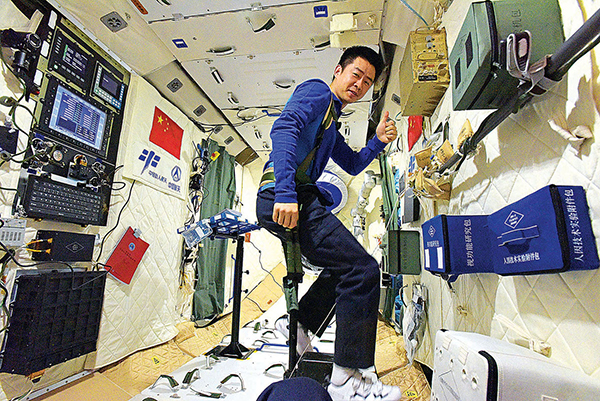
Astronaut Chen Dong uses an exercise bike made by Orient Fitness and Health Industrial in the Tiangong II space laboratory. [Photo for China Daily]
During a recent video sent from the core module of China's space station Tianhe (Harmony of the Heavens), an exercise bike attracted lots of attention from viewers.
China launched its seventh manned space mission Shenzhou XII on June 17. Three astronauts are on board Tianhe during a three-month mission, during which they require regular exercise.
On June 23, astronaut Nie Haisheng opened a package containing an exercise bike and assembled it in five minutes.
"During an extended period in the space station, astronauts undergo a series of adaptive changes, such as changes in their cardiovascular systems, muscle atrophy and bone loss," said Qin Younian, head of the space program at Orient Fitness and Health Industrial, a company based in Changzhi, Shanxi province, that developed the bike.
"They need daily exercise time, and the equipment can help them maintain strong bodies and prevent cardiovascular dysfunction, bone calcium loss and muscle atrophy," Qin said.
It was not the first time Shanxi Orient had seen its exercise equipment being used in space.
The company started researching space fitness equipment in 2006, applying its technical and scientific knowledge to its efforts.
"Even though we had been focusing on fitness equipment since 1991, we had no connection with the aerospace industry until the company was selected for the task by the General Administration of Sport of China, the National Sporting Goods Quality Supervision and Inspection Center and the China Astronaut Research and Training Center," Qin said.
The company immediately set up a research team consisting of about 10 members to develop the space exercise bike.
"Product development involved many fields, including aerodynamics, ergonomics and mechanics," Qin said. "Because there had been no experience for the team to draw on, we had to figure things out on our own."
The first challenge was to choose raw materials that were light, durable and reliable. The team also had to ensure the equipment was safe and simple in structure so the astronauts could easily assemble it.
Members of the team used simulation software to repeatedly optimize the design of each component.
Finally, they chose carbon fiber to make the shell, titanium alloy for the cranks and screws and aluminum alloy for the frame after numerous tests.
In 2012, Liu Yang, China's first female astronaut, became the first to test the exercise bike in the Tiangong I space lab.
In subsequent years, the company developed other space fitness equipment, including a treadmill for daily exercise.
In 2017, the company invited Liu Wang and Zhang Xiaoguang, two astronauts who had used Shanxi Orient's fitness equipment during their space missions, and experts in fitness and the aerospace industry to promote the development of the equipment.
Based on their experience and professional perspectives, they spent a whole day discussing the appearance, materials and functions such equipment should have.
"We all felt so lucky to get so many valuable suggestions for the promotion of our equipment," Qin said.
"Compared with equipment used in the Tiangong I and Tiangong II space labs, the newest equipment has the largest volume and weight. We also spent the most time developing it and solving the most difficult problems."
To make the astronauts feel more comfortable, the company produced nearly 20 sets of binding equipment, such as seat belts, for the astronaut training center and changed the design of the back cushion and handlebars to make them more comfortable.
"We have made plans for the next decades," Qin said.
"We will never stop conducting research and promoting our space fitness equipment."
Hao Hushan, general manager of the company, said: "As the only enterprise developing and producing aerospace fitness equipment in China, we are deeply aware of the heavy responsibility. We will stick to the spirit of innovation, elaboration and persistence."